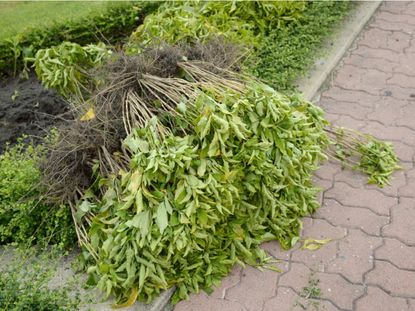Uprooted Plant Damage: Dealing With Uprooted Plants


Despite all your planning and care, nature and animals have a way of messing up the garden and landscape in ways that may seem needlessly cruel to the plants involved. Uprooted garden plants are a very common gardening problem, especially in areas prone to high winds. Trees, garden vegetables, and perennials are frequent victims. Keep reading for information on what to do about plant roots coming out of the ground.
Can Uprooted Plants be Saved?
Yes, sometimes uprooted plants can be saved. That's the best answer you'll get out of an experienced gardener because dealing with uprooted plants is a gamble at best. Uprooted plant damage ranges in severity from annoying and cosmetic to extremely damaging, especially when large portions of the root system are broken or left exposed to the air for extended periods. Tree roots coming out of the ground are especially problematic, both because of the challenge of up-righting the tree and of re-anchoring it. Small plants that have been uprooted for a very short time and not allowed to dry out are the easiest to save. These plants may have lost a few root hairs but aren't going to experience anything more than minor transplant shock. As plant size and exposure time increase, the outcome of your rescue operation is much less certain, but it's always worth trying. If you just leave the plant uprooted, there's zero chance it'll survive, whereas even the most stressed uprooted plant might survive with enough care.
How to Replant an Uprooted Plant
When a plant has been uprooted, you must act quickly and decisively in order to save it. First, inspect the rootball carefully for breaks and damage. If the roots are white and relatively intact, your plant is healthy, so wet the rootball well and replant it where it belongs. Small plants dug by dogs or other wild animals can usually be convinced to remain stable simply by watering them well and leaving them alone. Bigger plants, however, will need more convincing. You'll need to supply extra support for larger bushes and trees uprooted by wind or other accidents since they're often top-heavy and won't be able to compensate right away. Resist the urge to trim trees and bushes at this time-- they're going to need all the leaves they have to feed their new root growth. Many gardeners tie them to posts or pins secured in the ground, with the tension pulling in the opposite direction of the tree's new lean. Boards can also be wedged between the trunk and the ground at an angle to help hold the tree upright. Using both methods in combination may yield the best results. Wait to fertilize your plant with nitrogen until it starts to show signs of new growth since it doesn't need the added stress associated with putting out a lot of shoots while it's trying to anchor itself to the ground. Remove the supports several times a month to check the steadiness of your plant; reinstall them if the tree can be wiggled in its hole even a little bit. Remember to water your troubled plant well and often-- it may be missing a significant portion of its roots and unable to bring enough water into its system to meet its needs.
Gardening tips, videos, info and more delivered right to your inbox!
Sign up for the Gardening Know How newsletter today and receive a free download of our most popular eBook "How to Grow Delicious Tomatoes."

Kristi Waterworth was a regular contributor to Gardening Know How for many years, answering countless queries on plant pests and diseases.
-
 How To Get Rid Of Mosquitoes In The Garden: 9 Natural Ways To Make Them Buzz Off!
How To Get Rid Of Mosquitoes In The Garden: 9 Natural Ways To Make Them Buzz Off!How to get rid of mosquitoes is on the minds of people in the summer in almost every region of the world. Learn how to repel the pests without toxic chemicals.
By Mary Ellen Ellis
-
 Monkey Orchid Care: How To Grow This Fascinating Species
Monkey Orchid Care: How To Grow This Fascinating SpeciesThe monkey orchid (Dracula simia) bears a remarkable resemblance to its namesake and, with a little know-how, can be successfully grown as a houseplant.
By Bonnie L. Grant